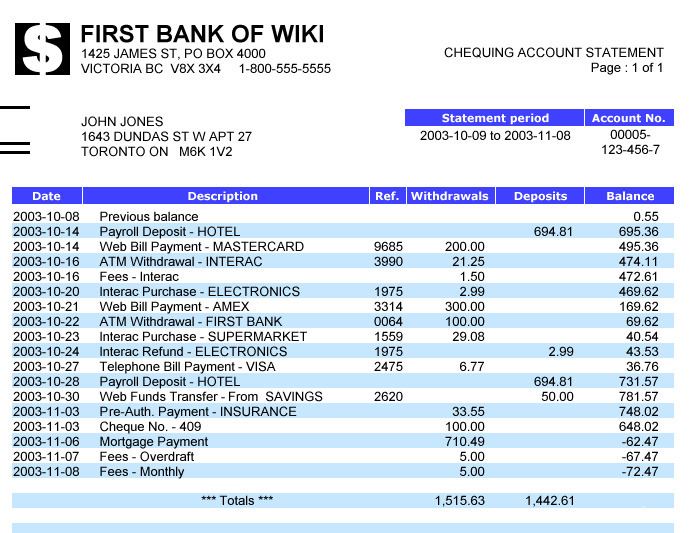 | ||
A bank statement or account statement is a summary of financial transactions which have occurred over a given period on a bank account held by a person or business with a financial institution.
Contents
Bank statements have historically been and continue to be typically printed on one or several pieces of paper and either mailed directly to the account holder, or kept at the financial institution's local branch for pick-up. In recent years there has been a shift towards paperless, electronic statements, and some financial institutions offer direct download into account holders accounting software.
Some ATMs offer the possibility to print, at any time, a condensed version of a bank statement, commonly called a transaction history, or a transaction history may be viewed on the financial institution's website or available via telephone banking.
Paper statements
Historically, bank statements were paper statements produced monthly, quarterly or even annually. Since the introduction of computers in banks in the 1960s, bank statements have generally been produced monthly. Bank statements for accounts with small transaction volumes, such as investments or savings accounts, are usually produced less frequently. Depending on the financial institution, bank statements may also include certain features such as the cancelled cheques (or their images) that cleared through the account during the statement period.
Some financial institutions use the occasion of posting bank statements to include notices such as changes in fees or interest rates or to include promotional material.
Today, the monthly mailing of bank statements is the norm in many countries. It is not customary in some countries, such as Japan, where individual account holders are expected to keep track of deposits, withdrawals, and balances using their own passbooks at ATMs.
Electronic statements
With the wider access to the Internet and online banking, bank statements (also known as electronic statements or e-statements) can be viewed online, and downloaded or printed by the customer. To reduce the cost of postage and the generation of paper bank statements, some financial institutions encourage their customers to receive bank statements electronically, for example by charging a fee for paper statements. This may be as attachments to emails or, as a security measure, as a reminder that a new statement is available on the financial institution's website. Whether such statements are transmitted as attachments or from the website, they are commonly generated in PDF format, to reduce the ability of the recipient to electronically alter the statement.
Due to identity theft concerns, an electronic statement may not be seen as a dangerous alternative against physical theft as it does not contain tangible personal information, and does not require extra safety measures of disposal such as shredding. However, an electronic statement can be easier to obtain than a physical one through computer fraud, data interception and/or theft of storage media.
